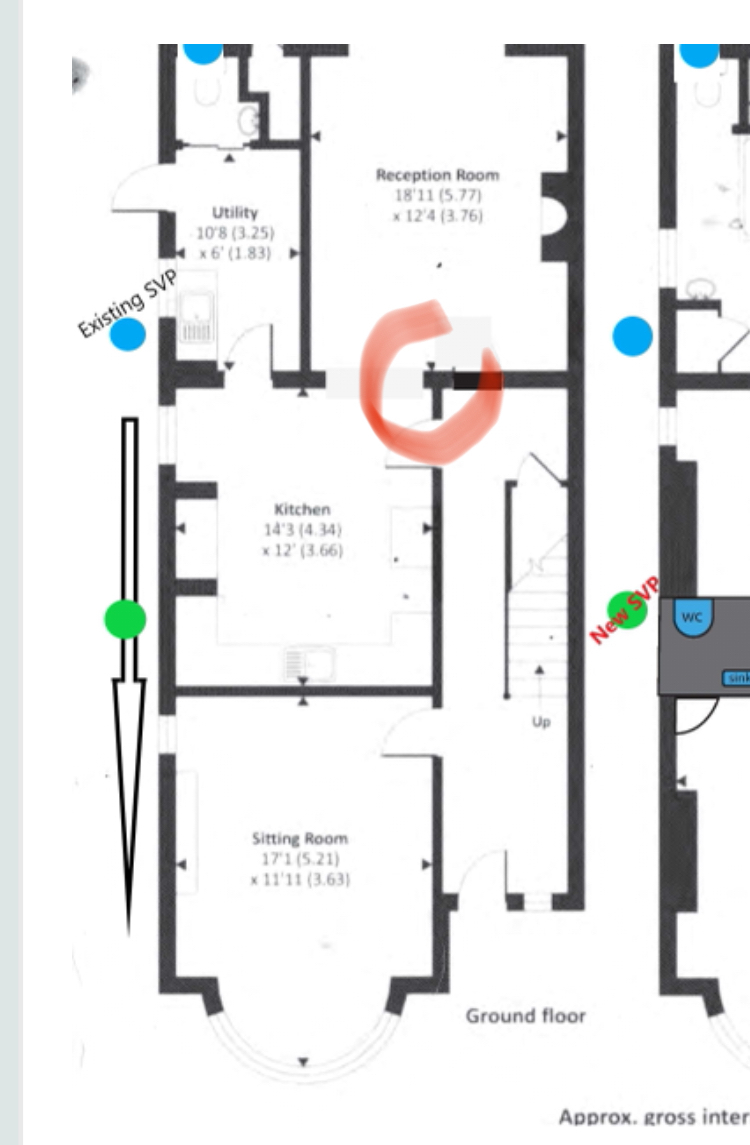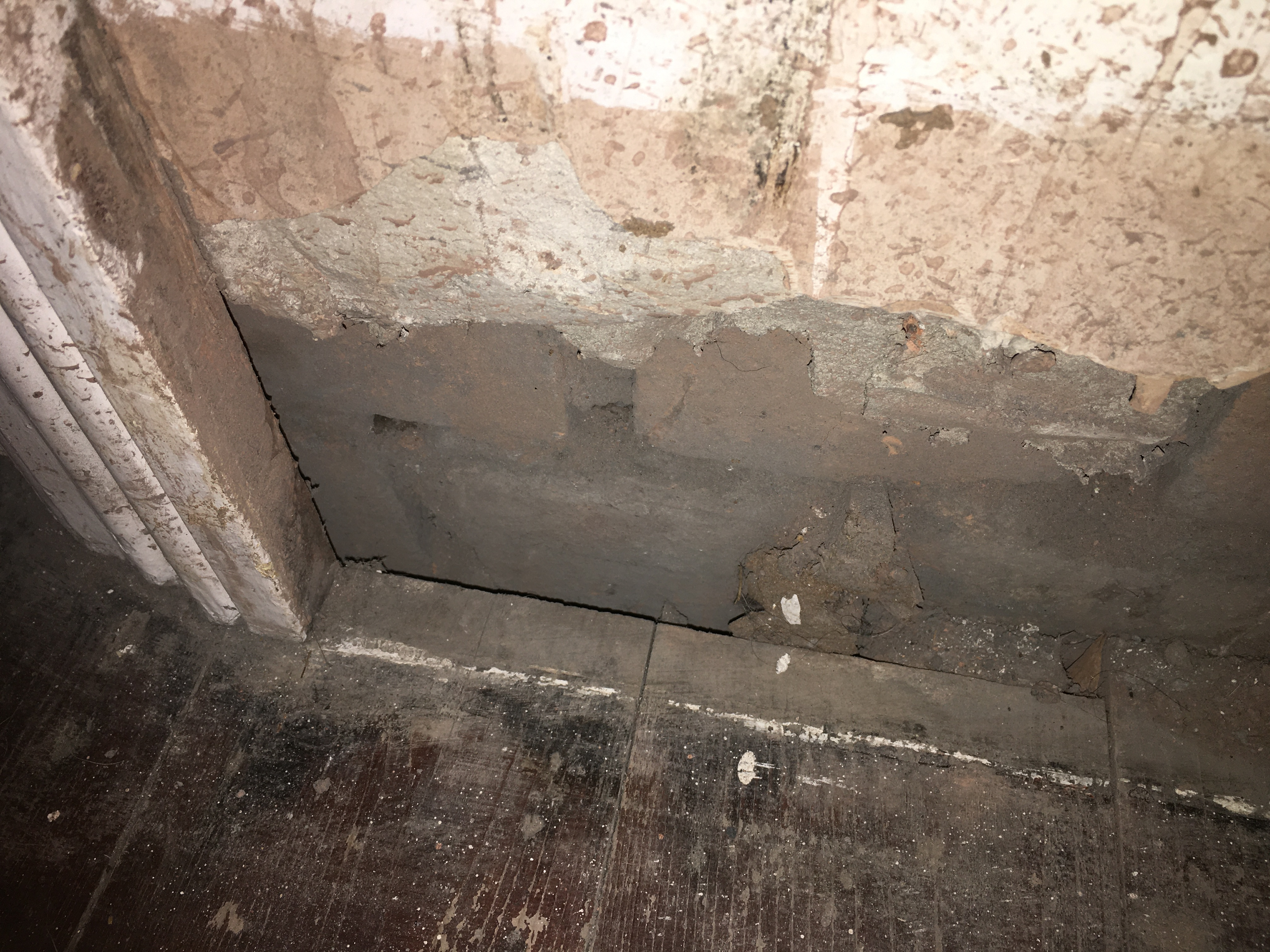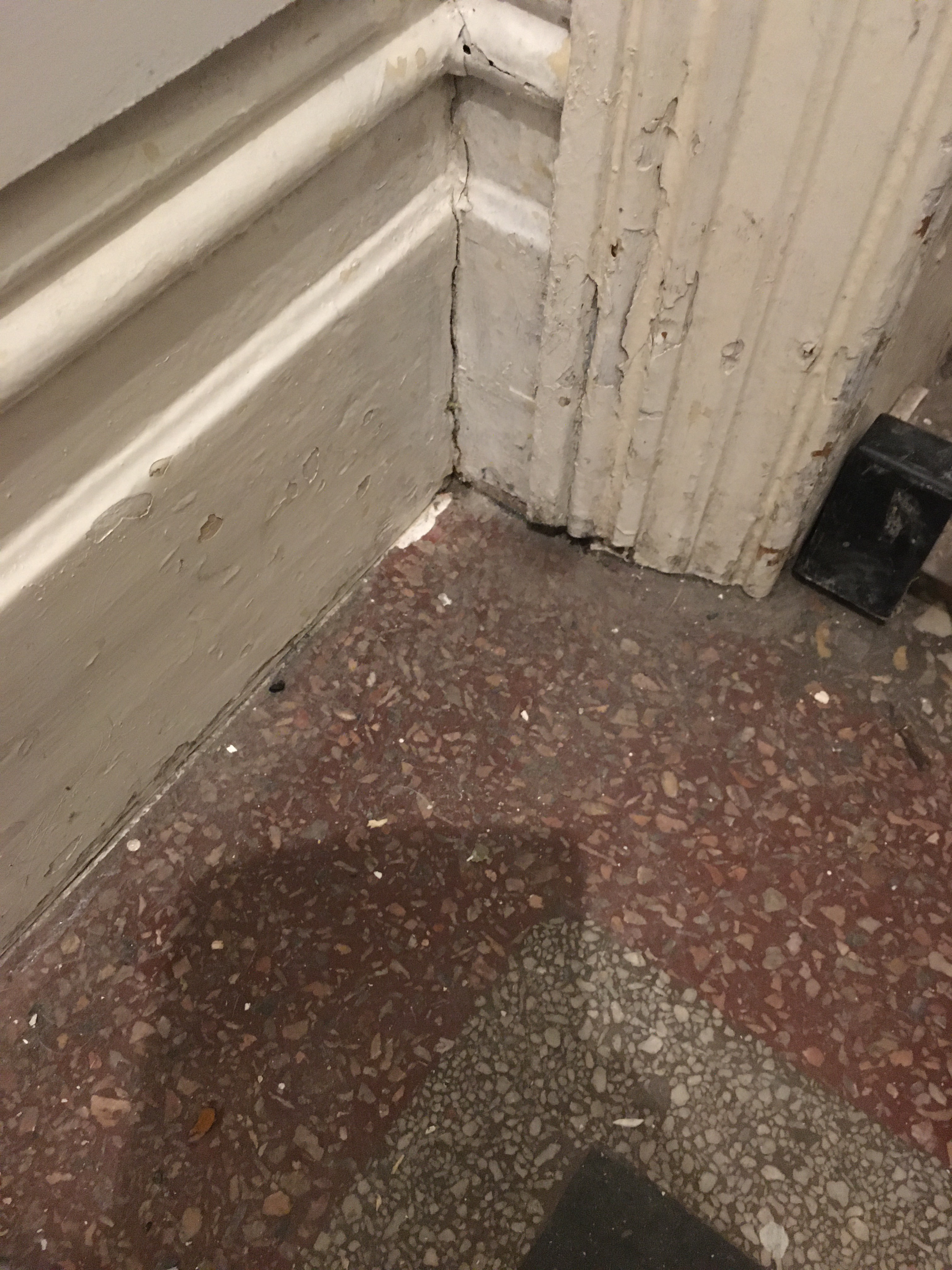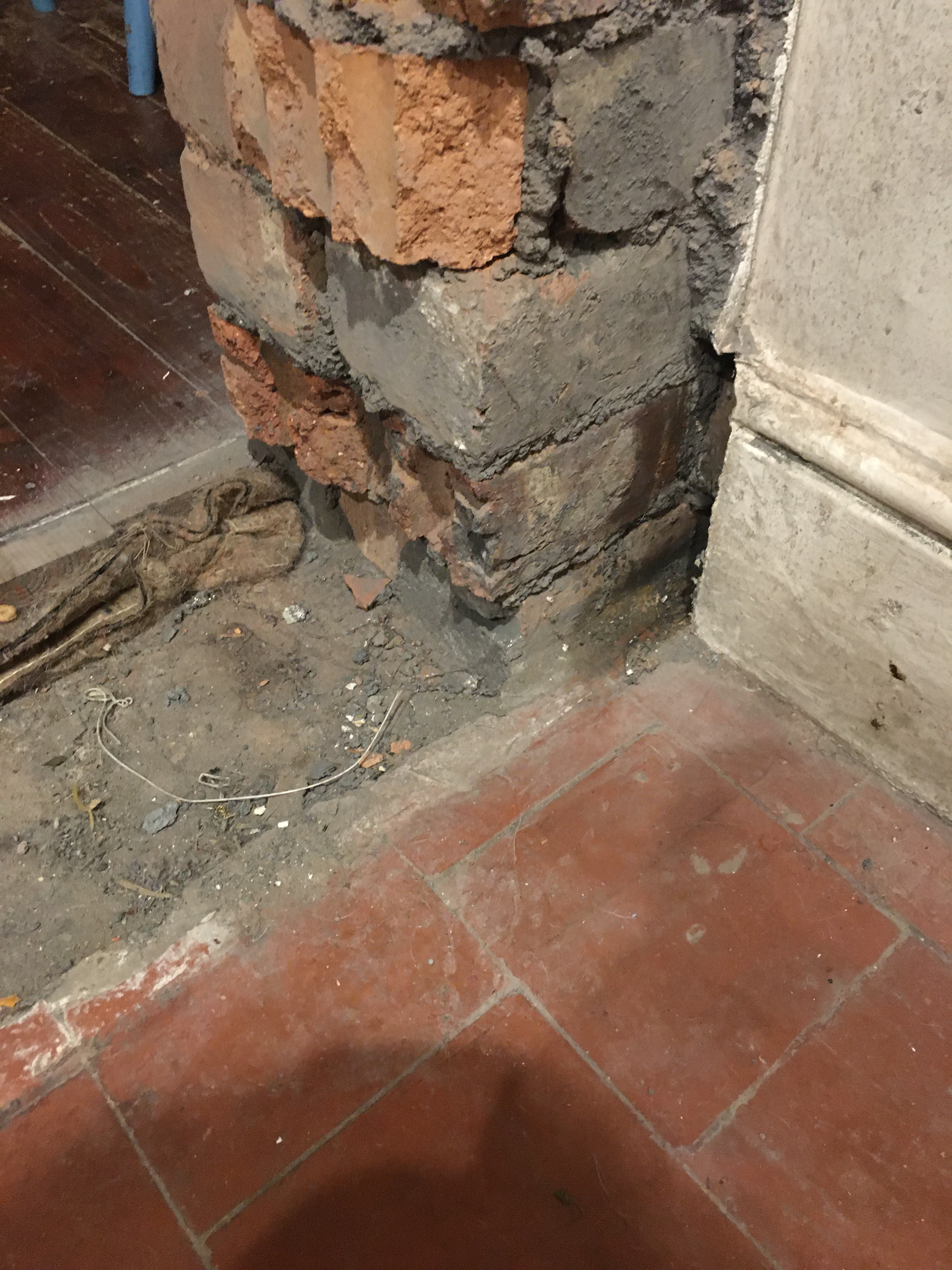We’d like to remind Forumites to please avoid political debate on the Forum.
This is to keep it a safe and useful space for MoneySaving discussions. Threads that are – or become – political in nature may be removed in line with the Forum’s rules. Thank you for your understanding.
📨 Have you signed up to the Forum's new Email Digest yet? Get a selection of trending threads sent straight to your inbox daily, weekly or monthly!
Damp patch has us stumped
ChasingtheWelshdream
Posts: 947 Forumite






Hi folks,
We had an opening made between our kitchen and dining room some weeks back. Everything is fine and we just need to cover everything up and make good.
The kitchen is original quarry tiles, the dining room is suspended floorboards and the adjoining hallway is original terrazzo. House built 1910.
We have never had a visible damp issue before but in the last few days a random damp patch has appeared and we are quite simply flummoxed!
There are no pipes anywhere near, all walls are internal. It is just this one little area on one side, which is possibly creeping through to the hallway floor. I say possibly as I’m not sure it the small dark area in the corner is an old stain - it doesn’t feel damp but equally I have not noticed it before.
It is only showing on one side of the opening too (solid brick).
I know the quarries are likely laid on earth/ash and understand breathability from that respect, but I don’t understand how this small bit of the brick is showing damp. It would have been behind the skirting, but if it had been damp wouldn’t that have rotted over the years?
We had an opening made between our kitchen and dining room some weeks back. Everything is fine and we just need to cover everything up and make good.
The kitchen is original quarry tiles, the dining room is suspended floorboards and the adjoining hallway is original terrazzo. House built 1910.
We have never had a visible damp issue before but in the last few days a random damp patch has appeared and we are quite simply flummoxed!
There are no pipes anywhere near, all walls are internal. It is just this one little area on one side, which is possibly creeping through to the hallway floor. I say possibly as I’m not sure it the small dark area in the corner is an old stain - it doesn’t feel damp but equally I have not noticed it before.
It is only showing on one side of the opening too (solid brick).
I know the quarries are likely laid on earth/ash and understand breathability from that respect, but I don’t understand how this small bit of the brick is showing damp. It would have been behind the skirting, but if it had been damp wouldn’t that have rotted over the years?
It is well above the dpc, no gypsum plaster except for some patch repairs, no external walls, only appeared in the last couple of weeks and no damp anywhere else near! Good airflow (think draughty) under the floorboards.
We even wondered if the dog had decided to mark his territory but we’re pretty sure he hasn’t!
Obviously we can’t begin make good until we fix it but am unsure where to start looking.
Anyone have any clues?
The pictures show the damp (kitchen quarry side, bottom picture) dining room side (floorboards top) and adjoining hallway (middle) It is the red circle on the floor plan.




The pictures show the damp (kitchen quarry side, bottom picture) dining room side (floorboards top) and adjoining hallway (middle) It is the red circle on the floor plan.




0
Comments
-
Kinda stumped too...However, one observation - You have quite a build up of muck & debris at the end of the floorboards. It would be a good idea to vacuum as much as you can up. If left, it could encourage moisture to wick up into the floorboards and cause them to rot.Any language construct that forces such insanity in this case should be abandoned without regrets. –
Erik Aronesty, 2014
Treasure the moments that you have. Savour them for as long as you can for they will never come back again.3 -
Good point thanks. Yes we need to do a lot of cleaning still but I hadn’t thought about the debris wicking.
There is the original door at the end of the hallway which isn’t shown on the plans as we are going to block it up. So that bit of brickwork is now effectively a brick pillar, it really is a completely isolated damp spot.
I am going to take off the remaining skirting either side and see if it has spread further. It has definitely got more ‘definite’ over the days so I want to see where it has tracked. I can also take out the architrave and see if it has tracked upwards unseen.
The only thing I can think of is the dpc has suddenly failed in that one spot, but assuming there is one anyway, the dpc on the exterior wall is bitumen/hessian. I wouldn’t have thought this would suddenly fail, more degrade over time.
Completely flummoxed but also a little panicky and I am getting a little obsessive looking at it!1 -
Are you certain that it appeared recently or could you just not have noticed it when the floor was first lifted?ChasingtheWelshdream said:...We have never had a visible damp issue before but in the last few days a random damp patch has appeared and we are quite simply flummoxed!..
Is it actually damp or is it a stain of some sort?
The reason I ask that is, when we had carpets lifted for replacement last year I noticed a damp patch on the floor immediately in front of the patio doors and my first thought was that rain water was blowing in at the base of the French doors.
However, when I knelt down for a close look it wasn't damp but merely a stain from adhesive used to secure the gripper rods and underlay in the little recess for the doors. It really did look exactly like a damp patch.A man walked into a car showroom.
He said to the salesman, “My wife would like to talk to you about the Volkswagen Golf in the showroom window.”
Salesman said, “We haven't got a Volkswagen Golf in the showroom window.”
The man replied, “You have now mate".2 -
We have wondered if we just hadn’t noticed, but it has definitely got darker over the days.1
-
That could possibly just be exposure to the air or dust and dirt settling on it if it is slightly sticky?ChasingtheWelshdream said:We have wondered if we just hadn’t noticed, but it has definitely got darker over the days.
Does it feel damp when compared to the areas around the patch?A man walked into a car showroom.
He said to the salesman, “My wife would like to talk to you about the Volkswagen Golf in the showroom window.”
Salesman said, “We haven't got a Volkswagen Golf in the showroom window.”
The man replied, “You have now mate".2 -
It’s really hard to tell really.Someone has suggested taping some acetate over for a couple of days to see if it gets wet on the underside, so that’s going to be my first thing I think.1
-
ChasingtheWelshdream said: The only thing I can think of is the dpc has suddenly failed in that one spot, but assuming there is one anyway, the dpc on the exterior wall is bitumen/hessian. I wouldn’t have thought this would suddenly fail, more degrade over time.
A DPC does not "fail" unless subjected to some serious physical damage. Nor do they degrade over time. Being at the base of a wall, they are well protected from the elements and any atmospheric attack that might affect bitumen.
Any language construct that forces such insanity in this case should be abandoned without regrets. –
Erik Aronesty, 2014
Treasure the moments that you have. Savour them for as long as you can for they will never come back again.2 -
Could it be that where the skirting has been removed, a gap has opened to the underfloor void of the dining room. The emerging cold air direct from the airbricks then agressively cools that brickwork causing it to attract condensation, being close to the kitchen.2
-
I was thinking along the lines of this ... Condensationcoffeehound said:Could it be that where the skirting has been removed, a gap has opened to the underfloor void of the dining room. The emerging cold air direct from the airbricks then agressively cools that brickwork causing it to attract condensation, being close to the kitchen.2 -
Checking the temp of the bricks with a surface thermometer will help tell if condensation will be forming as long as you know the air temp and R/H.
Needs checking at various times.2
Confirm your email address to Create Threads and Reply

Categories
- All Categories
- 351.8K Banking & Borrowing
- 253.4K Reduce Debt & Boost Income
- 454K Spending & Discounts
- 244.7K Work, Benefits & Business
- 600.2K Mortgages, Homes & Bills
- 177.3K Life & Family
- 258.4K Travel & Transport
- 1.5M Hobbies & Leisure
- 16.2K Discuss & Feedback
- 37.6K Read-Only Boards



